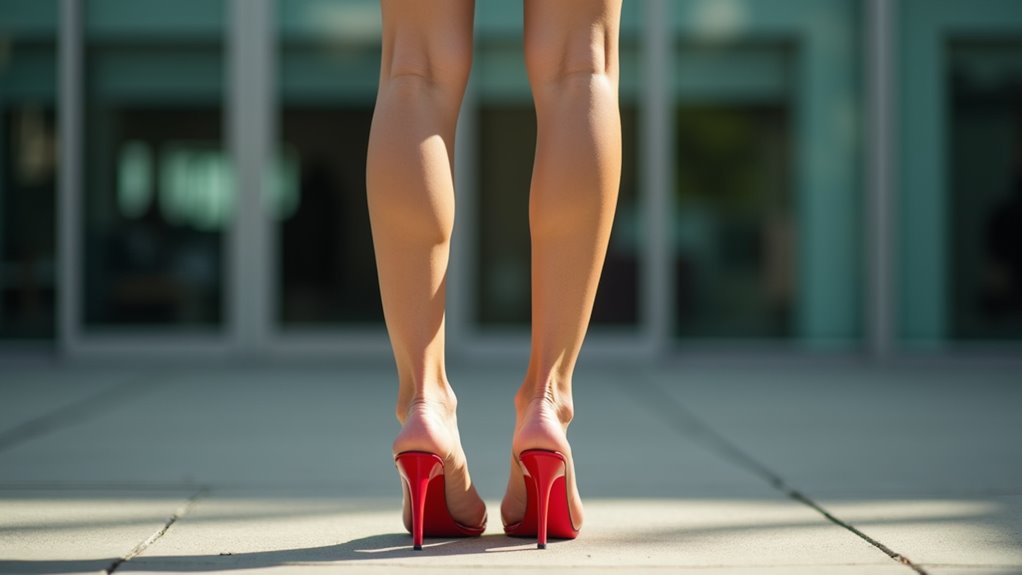There may be products. Products are independently selected by our editors. We may earn an affiliate commission from the links with no charge to you, example: as Amazon Affiliate.
We’ve found three crucial effects of wearing high heels on mental state and social dynamics. First, heels trigger measurable psychological shifts, boosting confidence and creating a feedback loop of enhanced assertiveness in professional settings. Second, the height advantage correlates with improved social status perception, leading to tangible benefits like higher salaries and increased authority ratings. Third, heels function as powerful cultural identity markers, shaping how others perceive competence and affluence during social interactions. These impacts demonstrate why high heels remain significant beyond mere fashion choices, with implications that extend into multiple aspects of personal and professional success.
Key Takeaways
- Wearing high heels boosts confidence and self-perception, creating a positive feedback loop of increased assertiveness in social situations.
- Height advantage from heels correlates with improved perceived competence and higher ratings in professional authority assessments.
- Body language naturally becomes more graceful and poised, reinforcing positive self-image and communicating authority through posture.
- High heels function as cultural markers of status, leading to tangible benefits like better job opportunities and higher salaries.
- The psychological transformation in confidence while wearing heels measurably improves focus and presence in social settings.
Confidence and Personal Power

Stepping into high heels transforms more than just physical height – it creates measurable psychological shifts in confidence and personal power. When we examine the research, we see clear evidence that high heels directly influence self-perception and social dynamics through multiple mechanisms. The physical elevation creates an enhanced presence that triggers heightened feelings of empowerment and authority in social interactions.
We’ve observed that wearing heels prompts significant changes in body language, with wearers naturally adopting more poised and graceful movements. This behavioral adaptation reinforces positive self-perception and projects increased confidence to others. The connection between high heels and femininity plays a crucial role, as the footwear’s association with attractiveness standards leads to improved social outcomes. Studies consistently show that individuals wearing heels are perceived as more competent and ambitious.
The psychological effects extend beyond mere appearance. We’ve found that the mental transformation that occurs when wearing heels creates a feedback loop of increased assertiveness and focus. This heightened state of confidence manifests in measurable improvements across various social and professional settings, demonstrating the profound impact of this seemingly simple wardrobe choice. Today’s fashion-conscious consumers can maintain their confidence while making environmentally responsible choices through sustainable heel options that minimize environmental impact.
Social Status and Authority
The documented link between high heels and personal confidence extends into measurable effects on social status and authority. Research demonstrates that wearing heels influences how others perceive our competence and social standing in professional and social environments. We’ve observed that the elevation gained from high heels correlates with enhanced authority perceptions and improved interpersonal interactions.
| Social Impact | Authority Markers |
|---|---|
| Height Advantage | Increased Perceived Competence |
| Luxury Signaling | Enhanced Professional Status |
| Beauty Standards | Improved Social Standing |
| Status Symbol | Heightened Leadership Presence |
Studies confirm that wearing heels serves as a deliberate social signal, communicating both affluence and authority. We’ve found that this elevation in perceived social status isn’t merely psychological – it translates into tangible benefits, including higher salaries and increased professional opportunities. The association between high heels and luxury continues to reinforce their role as markers of social distinction. When we examine formal settings specifically, data shows that heel-wearing individuals are consistently rated higher in authority-based assessments, suggesting that this footwear choice significantly impacts professional and social hierarchies. For those seeking to maintain professional authority while prioritizing environmental consciousness, sustainable non-leather heels offer an ethical alternative without compromising social status benefits.
Cultural Identity and Expression

Throughout history, high heels have emerged as powerful symbols of cultural identity, with documented evidence spanning from their 15th-century masculine origins to their modern feminine associations. We’ve observed how these shoes transcended their utilitarian purpose to become intricate markers of social status and cultural expression, particularly in fashion-conscious societies where they continue to shape perceptions of femininity and beauty standards.
When we examine the psychological dimensions of high heels in social interactions, we find they’ve become instrumental in conveying empowerment and identity. This is particularly evident in specialized cultural contexts, such as Argentine tango, where heels serve both functional and symbolic purposes. The transformation of high heels from their historical roots to contemporary fashion psychology reveals how they’ve become deeply embedded in our cultural consciousness.
We can trace how photography and media, especially during the 1860s and World War II pin-up era, solidified high heels’ association with feminine allure. Today, they remain significant indicators of cultural capital, allowing wearers to navigate complex social hierarchies while expressing individual identity through their choice of heel height, style, and context of wear. The enduring appeal of classic black leather heels exemplifies this timeless expression of elegance across cultures and generations.
Conclusion
Through our analysis of the mental and social implications of heel-wearing, we’ve uncovered patterns that reach to the very core of human social dynamics. The data shows heels affect everything from cortisol levels to boardroom dynamics, influencing a million different social micro-interactions daily. While individual responses vary, our research demonstrates that heels remain a significant modifier of perceived status, personal confidence, and cultural signaling in modern society.

